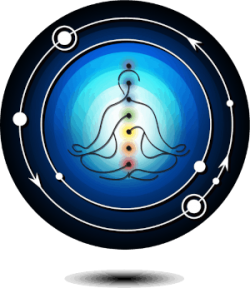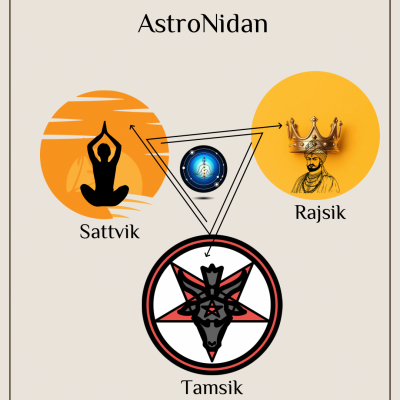“Guna” refers to qualities, virtues, properties, and merits. It provides a deeper understanding of the characteristics, tendencies, thoughts, emotions, and behaviours of all beings and things.
These gunas influence our actions, dominant traits, and ways of behaving. Lord Krishna in the Bhagavadgita enlightens us on the qualities of Sattva, rajas, and tamas and how they impact human behaviour.
Vedic literature (Sankhya Yoga) and the Indian spiritual text “Bhagwad Gita” provide the basic framework for the concept of Indian psychology based on the relationship between yoga-based mental attributes (Gunas) and human behaviour. Vedic literature describes three Gunas – Sattva, Rajas and Tamas, representing illumination, activity, and inertia, respectively. These are the three fundamental qualities of human personality.
Sattva is the quality of intelligence that creates harmony, balance, and awakening and generates tendencies toward selfless service, disinterested affection, purity of heart, control over senses, truthfulness and compassion toward other beings.
Rajas is the quality of action, passion, and change. It brings forth the characteristics of ambition, restlessness, discontentment, envy and sensuousness along with positive qualities of constructivism, passion, industriousness and enthusiasm.
Tamas is the quality of dullness, ignorance, fear and inertia. It brings a state of mental rigidity, apathy, delusion and destruction. The three tendencies promote different temperaments, leading to the formation of personality based on the Guna dominance.
Sattva, Rajas, And Tamas from Vedic Hinduism
Because these are Maha Gunas and run through the fabric of the Universe, ancient Hindus assigned deities to these qualities. According to Hindu mythology, there are three main deities that are responsible for the creation, sustenance, and destruction of the Universe.
These deities are Vishnu, Brahma, and Shiva. Vishnu is considered the sustaining force responsible for maintaining the balance and harmony in the Universe. Brahma is the creative force responsible for the creation of the Universe and all living beings. Shiva is the destroyer, responsible for the destruction of the Universe and all that exists within it.
In addition to their roles in creation, sustenance, and destruction, these deities are also associated with the three Gunas, which are the three fundamental qualities of nature. Vishnu is associated with the Sattva Guna, which represents purity, goodness, and harmony. Brahma is associated with the Rajo Guna, which represents passion, energy, and activity. Shiva is associated with the Tamo Guna, which represents darkness, inertia, and destruction. Together, these three deities and their associated Gunas form the basis of Hindu philosophy and provide a framework for understanding the nature of the Universe.
Guna, as mentioned in Bhagavad Gita
Chapter XIV of the Bhagavad Gita explains the concept of duality in the world. It explains that the Universe consists of two intertwined and inseparable aspects: the material (prakriti) and the spiritual (purusha). The former refers to existence’s tangible and observable components, such as matter, energy, and nature. At the same time, the latter is an abstract concept that refers to the essence of life itself. Purusha is often described as the eternal consciousness that pervades all of existence and gives us self-awareness, intelligence, and the ability to experience the world around us.
The Bhagavad Gita teaches us that the material and spiritual aspects of the world are not separate or opposing forces but rather two sides of the same coin. They are intertwined and interconnected, and one cannot exist without the other. By understanding and embracing this duality, we can better understand ourselves and our place in the world.
In addition, the Bhagavad Gita explains that matter has three qualities or gunas. Lucidity (Sattva) represents a clear and pure nature, while passion (Rajas) represents an active and dynamic nature. Inertia (Tamas) represents a dull and sluggish nature. Everything in nature displays these three qualities in different proportions.
The Physics behind “Guna”
Sattva, Rajas, and Tamas Guna relate to consciousness and spirituality in Hindu philosophy. While there are metaphorical connections to physics concepts, which are primarily speculative.
Sattva, Rajas, and Tamas are the very first qualities of this Universe.
- Sattva and Quantum Mechanics: Quantum physics deals with the behavior of matter and light on the atomic and subatomic scale. Sattva is associated with consciousness and awareness. In quantum physics, there is a phenomenon known as the observer effect, which suggests that the observer’s consciousness can affect the behavior of subatomic particles. This is similar to the concept of Sattva.
- Rajas and Kinetic Energy: Rajas, associated with activity, restlessness, and desire, could be metaphorically linked to the concept of kinetic energy in physics. Kinetic energy is associated with the motion of objects and is a form of energy associated with activity and change.
- Tamas and Entropy: Tamas, representing inertia, ignorance, and darkness, could be metaphorically related to the concept of entropy in physics. Entropy is a measure of disorder or randomness in a system. In a closed system, entropy tends to increase, reflecting a tendency toward more significant disorder and equilibrium.
Astrology and Guna
The gunas also play out in the grahas, which we look to for deeper interpretation. For instance, Saturn is quite tamasic, especially when Saturn is placed in a tamasic sign; it can affect the person. Whereas, Saturn has tamasic qualities, but strongly placed or in the sign of its exaltation, it is able to become more sattvic.
These gunas can also be determined by the sign rulers instead of the signs, wherein tamasic signs are those ruled by tamasic grahas Mars and Saturn: Aries, Scorpio, Capricorn, Aquarius; rajasic signs are those ruled by rajasic grahas Venus and Mercury: Taurus, Gemini, Virgo and Libra; and sattvic signs are those ruled by sattvic grahas Moon, Sun and Jupiter: Cancer, Leo, Sagittarius and Pisces. Each Nakshatra also has a certain guna which you will find in any basic characteristics of the Nakshatra table. For example, Ashwini Nakshatra is Rajas, Bharani is Tamas and Krittika is Sattva.
As per Ayurveda, Prakriti (constitution) of an individual is determined at the time of the birth of an individual, but it also advocates the possibility of modification of the mental constitution (Gunas) by following certain traditional lifestyle practices. These practices involve the components of Ahara (diet), Vihara (recreation and sleep), Vyavahara (behavior) and Vichara (cognition) and targets the modification of a particular guna.
Astronidan using astrological calculations measure the balance of the gunas through the placements of all the planetary bodies (grahas) in the signs to understand an individual’s profile. Analyzing the natal chart this way can tell us more about an individual’s in-born inclination towards a certain Guna or Gunas.
It’s also important to note that these gunas are not fixed categories but rather dynamic aspects of one’s personality. People can exhibit varying degrees of each guna at different times and in different situations. The three Gunas are in dynamic interaction with each other, one gaining dominance and then receding, collapsing into each other, always maintaining the overall balance. Balancing the gunas is a life requires patience and self-awareness. It’s not about suppressing qualities but harmonizing them for a more fulfilling life.



